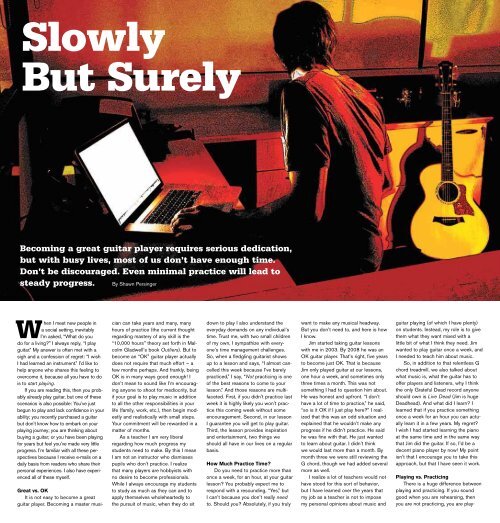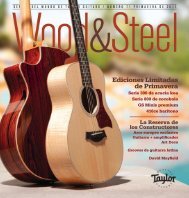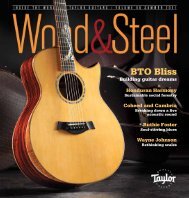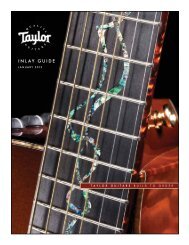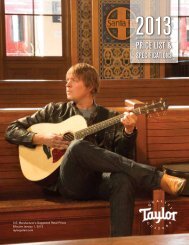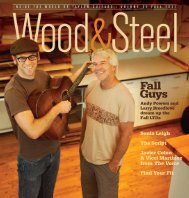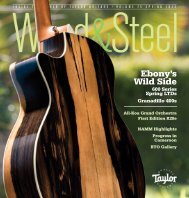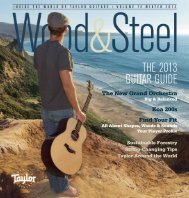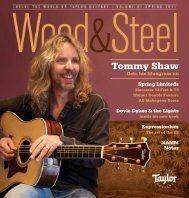The 2012 Taylor Line - Taylor Guitars
The 2012 Taylor Line - Taylor Guitars
The 2012 Taylor Line - Taylor Guitars
Create successful ePaper yourself
Turn your PDF publications into a flip-book with our unique Google optimized e-Paper software.
Slowly<br />
But Surely<br />
Becoming a great guitar player requires serious dedication,<br />
but with busy lives, most of us don’t have enough time.<br />
Don’t be discouraged. Even minimal practice will lead to<br />
steady progress. By Shawn Persinger<br />
When I meet new people in<br />
a social setting, inevitably<br />
I’m asked, “What do you<br />
do for a living?” I always reply, “I play<br />
guitar.” My answer is often met with a<br />
sigh and a confession of regret: “I wish<br />
I had learned an instrument.” I’d like to<br />
help anyone who shares this feeling to<br />
overcome it, because all you have to do<br />
is to start playing.<br />
If you are reading this, then you probably<br />
already play guitar, but one of these<br />
scenarios is also possible: You’ve just<br />
begun to play and lack confidence in your<br />
ability; you recently purchased a guitar<br />
but don’t know how to embark on your<br />
playing journey; you are thinking about<br />
buying a guitar; or you have been playing<br />
for years but feel you’ve made very little<br />
progress. I’m familiar with all these perspectives<br />
because I receive e-mails on a<br />
daily basis from readers who share their<br />
personal experiences. I also have experienced<br />
all of these myself.<br />
Great vs. OK<br />
It is not easy to become a great<br />
guitar player. Becoming a master musi-<br />
cian can take years and many, many<br />
hours of practice (the current thought<br />
regarding mastery of any skill is the<br />
“10,000 hours” theory set forth in Malcolm<br />
Gladwell’s book Outliers). But to<br />
become an “OK” guitar player actually<br />
does not require that much effort — a<br />
few months perhaps. And frankly, being<br />
OK is in many ways good enough! I<br />
don’t mean to sound like I’m encouraging<br />
anyone to shoot for mediocrity, but<br />
if your goal is to play music in addition<br />
to all the other responsibilities in your<br />
life (family, work, etc.), then begin modestly<br />
and realistically with small steps.<br />
Your commitment will be rewarded in a<br />
matter of months.<br />
As a teacher I am very liberal<br />
regarding how much progress my<br />
students need to make. By this I mean<br />
I am not an instructor who dismisses<br />
pupils who don’t practice. I realize<br />
that many players are hobbyists with<br />
no desire to become professionals.<br />
While I always encourage my students<br />
to study as much as they can and to<br />
apply themselves wholeheartedly to<br />
the pursuit of music, when they do sit<br />
down to play I also understand the<br />
everyday demands on any individual’s<br />
time. Trust me, with two small children<br />
of my own, I sympathize with everyone’s<br />
time management challenges.<br />
So, when a fledgling guitarist shows<br />
up to a lesson and says, “I almost cancelled<br />
this week because I’ve barely<br />
practiced,” I say, “Not practicing is one<br />
of the best reasons to come to your<br />
lesson.” And those reasons are multifaceted.<br />
First, if you didn’t practice last<br />
week it is highly likely you won’t practice<br />
this coming week without some<br />
encouragement. Second, in our lesson<br />
I guarantee you will get to play guitar.<br />
Third, the lesson provides inspiration<br />
and entertainment, two things we<br />
should all have in our lives on a regular<br />
basis.<br />
How Much Practice Time?<br />
Do you need to practice more than<br />
once a week, for an hour, at your guitar<br />
lesson? You probably expect me to<br />
respond with a resounding, “Yes,” but<br />
I can’t because you don’t really need<br />
to. Should you? Absolutely, if you truly<br />
want to make any musical headway.<br />
But you don’t need to, and here is how<br />
I know.<br />
Jim started taking guitar lessons<br />
with me in 2003. By 2008 he was an<br />
OK guitar player. That’s right, five years<br />
to become just OK. That is because<br />
Jim only played guitar at our lessons,<br />
one hour a week, and sometimes only<br />
three times a month. This was not<br />
something I had to question him about.<br />
He was honest and upfront. “I don’t<br />
have a lot of time to practice,” he said,<br />
“so is it OK if I just play here?” I realized<br />
that this was an odd situation and<br />
explained that he wouldn’t make any<br />
progress if he didn’t practice. He said<br />
he was fine with that. He just wanted<br />
to learn about guitar. I didn’t think<br />
we would last more than a month. By<br />
month three we were still reviewing the<br />
G chord, though we had added several<br />
more as well.<br />
I realize a lot of teachers would not<br />
have stood for this sort of behavior,<br />
but I have learned over the years that<br />
my job as a teacher is not to impose<br />
my personal opinions about music and<br />
guitar playing (of which I have plenty)<br />
on students. Instead, my role is to give<br />
them what they want mixed with a<br />
little bit of what I think they need. Jim<br />
wanted to play guitar once a week, and<br />
I needed to teach him about music.<br />
So, in addition to that relentless G<br />
chord treadmill, we also talked about<br />
what music is, what the guitar has to<br />
offer players and listeners, why I think<br />
the only Grateful Dead record anyone<br />
should own is Live Dead (Jim is huge<br />
Deadhead). And what did I learn? I<br />
learned that if you practice something<br />
once a week for an hour you can actually<br />
learn it in a few years. My regret?<br />
I wish I had started learning the piano<br />
at the same time and in the same way<br />
that Jim did the guitar. If so, I’d be a<br />
decent piano player by now! My point<br />
isn’t that I encourage you to take this<br />
approach, but that I have seen it work.<br />
Playing vs. Practicing<br />
<strong>The</strong>re is a huge difference between<br />
playing and practicing. If you sound<br />
good when you are rehearsing, then<br />
you are not practicing, you are play-<br />
ing. Practicing means working on new<br />
material that challenges you; music that<br />
will not sound good at first. For beginners,<br />
this might mean picking up the<br />
tempo on your chord changes (Ex. 1).<br />
For intermediate players, you could try<br />
a couple of Mauro Giuliani’s 120 Studies<br />
for Right Hand Development (Ex.<br />
2). An advanced guitarist should try<br />
practicing more chords than you would<br />
ever play in a real-life situation (Ex. 3),<br />
meaning this is impractical but fun. Let<br />
me break down each of these examples<br />
and show you how all of them can<br />
benefit guitarists at all levels.<br />
Example 1 is one of the most<br />
ubiquitous chord progressions ever,<br />
used in literally thousands of songs (in<br />
varying orders, these four chords form<br />
the basis for songs as wide-ranging<br />
as “My Old School” by Steely Dan;<br />
“Nothing Else Matters” by Metallica;<br />
“<strong>The</strong> Passenger” by Iggy Pop; “Let<br />
it Be” by <strong>The</strong> Beatles; and countless<br />
folk and blues songs), with a slightly<br />
less common strumming pattern. <strong>The</strong><br />
chords should be easy for most players;<br />
even beginners should start with<br />
these chords. But beginners and even<br />
some intermediate players will find the<br />
strumming pattern a challenge, as the<br />
four measures shown here contain four<br />
different combinations of strums! Novices<br />
should ignore the strum pattern for<br />
now. Four down strums per measure<br />
will work just fine. From there move to<br />
eight strums, down and up. Advanced<br />
players should test their rhythmic notation<br />
reading.<br />
Examples 2a, 2b, 2c and 2d come<br />
from Mauro Giuliani’s right hand studies,<br />
which were first published in the<br />
early 19th century and have been utilized<br />
by the greatest fingerstyle players<br />
in the world for the past 200 years.<br />
<strong>The</strong> chords are all C moving to G7, but<br />
you should feel free to vary the chords<br />
to any you like; I suggest Am and Em<br />
as simple alternatives. Because this<br />
work is in the public domain, there<br />
are several sites on the Internet from<br />
which you can download all 120<br />
exercises. I recommend a routine of<br />
practicing every fifth or sixth study, as<br />
they are grouped into similar patterns.<br />
Beginners can attempt these right<br />
hand patterns without fingering any<br />
chords; just use open strings (maybe<br />
try an opening tuning). Advanced guitarists<br />
are encouraged to challenge<br />
themselves with fast tempos and multiple<br />
chord changes.<br />
Finally, Example 3 is an over-thetop<br />
variation on the progression known<br />
as “Rhythm Changes,” based on the<br />
Gershwin tune, “I Got Rhythm.” <strong>The</strong>re<br />
is a chord change on every single<br />
beat! As mentioned, utilization of this<br />
is quite impractical, but it should be<br />
fun for players looking to push their<br />
Ex. 1<br />
Ex. 2a: No. 3 Ex. 2b: No. 95<br />
Ex. 2c: No. 109<br />
Ex. 3<br />
chording ability to new levels. Beginners<br />
and intermediates should feel<br />
free to play only the first chord of each<br />
measure, for four beats.<br />
Just Do It<br />
Playing guitar does not have to be<br />
hard. It certainly presents challenges<br />
at first, but no more than any other<br />
new activity most people try…just<br />
don’t start with the F chord. Hopefully,<br />
if we ever meet at a party and I casually<br />
say to you, “I play guitar,” you can<br />
say, “So do I.”<br />
Ex. 2d: No. 111<br />
Shawn Persinger, a.k.a. Prester John,<br />
is a self-proclaimed “Modern/Primitive”<br />
guitarist who owns <strong>Taylor</strong> 410s<br />
and 310s. His latest sister CDs, Rise<br />
O’ Fainthearted Girls and Desire for<br />
a Straight <strong>Line</strong> (one instrumental,<br />
one vocal), with mandolinist David<br />
Miller, showcases a myriad of delightful<br />
musical paradoxes: complex but<br />
catchy; virtuosic yet affable; smart<br />
and whimsical. www.PersingerMusic.<br />
com<br />
7


